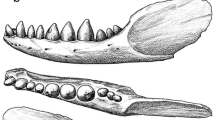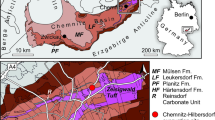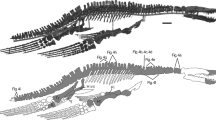Abstract
Thuringothyris mahlendorffae n.gen. n.sp. is described on the basis of the skull roof, palate, stapes and much of the postcranial skeleton from the Upper Rotliegend (Tambach-Schichten) of the Thuringian Forest in eastern Germany. The new taxon shows both protorothyridid and some captorhinid features. The interrelationships of the »Protorothyrididae«, primitive Captorhinidae, and earliest Diapsida are reviewd. The tetrapod material is used to reassess the biostratigraphic position of the fossil-bearing horizon.
Kurzfassung
Aus dem oberen Rotliegend (Tambach-Schichten) des Thüringer Waldes wirdThuringothyris mahlendorffae n. gen. n. sp. mit Schädeldach, Gaumen, Stapes und großen Teilen des Postkranialskelettes beschrieben. Diese Art zeigt charakteristische Merkmale der »Protorothyrididae« in Kombination mit einigen Merkmalen der Captorhinidae. Das Verwandtschaftsschema der »Protorothyrididae«, primitiven Captorhinidae und frühesten Diapsida wird neu interpretiert. Die biostratigraphische Position des Fundhorizontes wird an Hand der Tetrapodenfunde neu überdacht.
Similar content being viewed by others
Literatur
Ax, P. 1984. Das phylogenetische System. Systematisierung der lebenden Natur aufgrund ihrer Phylogenese. - 349 S., 90 Abb., G. Fischer, Stuttgart, New York.
Bermann, D. S. &Reisz, R. R. 1986. Captorhinid reptiles from the early Permian of New Mexico, with description of a new genus and species. - Annals of Carnegie Museum55: 1–28, 10 Abb., Pittsburgh, PA.
Berman, D. S.;Reisz, R. R. &Eberth, D. A. 1987a. A new genus and species of trematopid amphibian from the late Pennsylvanian of north-central New Mexico. - Journal of Vertebrate Paleontology7 (3): 252–269,11 Abb.,1 Tab., Lawrence, Kansas.
— 1987b:Seymouria sanjuanensis (Amphibia, Batrachosauria) from the Lower Permian Cutler Formation of north-central New Mexico and the occurrence of sexual dimorphism in that genus questioned. - Canadian Journal of Earth Sciences24 (9): 1769–1784, 10 Abb., Ottawa, Ontario.
Bolt, J. R. &Lombard, R. E. 1985. Evolution of the amphibian tympanic ear and the origin of frogs. -Biological Journal of the Linnean Society24: 83–99, 7 Abb., London.
Boy, J. A. 1977. Typen und Genese jungpaläozoischer Tetrapoden-Lagerstätten. - Palaeontographica A156 (4–6): 111–167, 17 Abb., Stuttgart.
— 1981. Zur Anwendung der Hennigschen Methode in der Wirbeltierpaläontologie. -Paläontologische Zeitschrift55 (1): 87–107, 9 Abb., Stuttgart.
— 1989. Is Phylogenetic Systematics applicable to completely extinct groups? - Abhandlungen des naturwissenschaftlichen Vereins Hamburg (NF)28: 125–137, 3 Abb., Hamburg.
Boy, J. A. &Bändel, K. 1973.Bruktererpeton fiebigi n.gen. n.sp. (Amphibia: Gephyrostegida), der erste Tetrapode aus dem rheinisch-westfälischen Karbon (Namur B; W.-Deutschland). - Palaeontographica A145 (1–3): 39–77, 19 Abb., Taf. 7-8, Stuttgart.
Boy, J. A. &Fichter, J. 1988. Zur Stratigraphie des höheren Rotliegend im Saar-Nahe-Becken (UnterPerm; SW-Deutschland) und seiner Korrelation mit anderen Gebieten. - Neues Jahrbuch für Geologie und Paläontologie, Abhandlungen176 (3): 331–394, 10 Abb., 1 Tab., Stuttgart.
Carroll, R. L. 1964. The earliest reptiles. - Journal of the Linnean Society (Zoology)45 (304): 61–83. 14 Abb., London.
— 1969 a. A middle Pennsylvanian captorhinomorph, and the interrelationships of primitive reptiles. -Journal of Paleontology43 (1): 151–170, 12 Abb., Tulsa, Okla.
— 1969b. Origin of reptiles. - [In:] Gans, C; Bellairs, A. & Parsons, T. S. (eds.) Biology of the Reptilia: 1–44, 14 Abb., Academic Press, London.
— 1970. The ancestry of reptiles. - Philosophical Transactions of the Royal Society of London, B257 (814): 267–308, 22 Abb., 3 Tab., London.
— 1982. Early evolution of reptiles. - Annual Review of Ecology and Systematics13: 87–109.
Carroll, R. L. &Baird, D. 1972. Carboniferous stem-reptiles of the family Romerndae. - Bulletin of the Museum of Comparative Zoology143 (5): 321–364, 14 Abb., 2 Taf., 1 Tab., Cambridge, Mass.
Carroll, R. L. &Gaskill, P. 1971. A captorhinomorph reptile from the Lower Permian of Europe. -Journal of Paleontology45 (3): 450–463, 7 Abb., Tulsa, Okla.
— 1978. The order Microsauria. - Memoirs of the American Philosophical Society126: 1–211, 135 Abb., 5 Tab., 3 Karten, Philadelphia, PA.
Clack, J. A. 1987a.Pholiderpeton scutigerum Huxley, an amphibian from the Yorkshire coal measures. - Philosophical Transactions of the Royal Society of London, B318 (1188): 1–107, 41 Abb., 6 Tab., 3 Append., London.
— 1987b. Two new specimens ofAnthracosaurus (Amphibia: Anthracosauria) from the Northumberland coal measures. - Palaeontology30 (1): 15–26, 7 Abb., 1 Tab., London.
Clark, J. &Carroll, R. L. 1973. Romeriid reptiles from the Lower Permian. - Bulletin of the Museum of Comparative Zoology144 (5): 353–407, 25 Abb., 2 Tab., 1 Taf., Cambridge, Mass.
Credner, H. 1889. Die Stegocephalen und Saurier aus dem Rothliegenden des Plauen’schen Grundes bei Dresden. VIII.Kadaliosaurus. - Zeitschrift der Deutschen geologischen Gesellschaft41: 319–342, 5 Abb., Taf. 15, Berlin.
Currie, P. J. 1979. The osteology of haptodontine sphenacodonts (Reptilia: Pelycosauria). - Palaeontogra- phica A163 (4–6): 130–168, 18 Abb., 4 Tab., Stuttgart.
Dilkes, D. W. 1990. A new trematopsid amphibian (Temnospondyli: Dissorophoidea) from the Lower Permian of Texas. - Journal of Vertebrate Paleontology10 (2): 222–243, 14 Abb., 2 Tab., Lawrence, Kansas.
Dilkes, D. W. &Reisz, R. R. 1986. The axial skeleton of the early Permian reptileEocaptorhinus laticeps (Williston). - Canadian Journal of Earth Sciences23: 1288–1296, 5 Abb., Ottawa, Ontario.
Eldredge, N. &Cracraft, J. 1980. Phylogenetic patterns and the evolutionary process. Method and theory in comparative biology. - 349 S., Abb. 1. 1-6.16, Columbia University Press, New York.
Fox, R. C. &Bowman, M. C. 1966. Osteology and relationships ofCaptorhinus aguti (Cope) (Reptilia: Captorhinomorpha). - University of Kansas Paleontological Contributions11: 1–79, 38 Abb., Lawrence, Kansas.
Gaffney, E. S. &McKenna, M. C. 1979. A late Permian captorhinid from Rhodesia. - American Museum Novitates2688: 1–15, 6 Abb., 2 Tab., New York, N.Y.
Gand, G. 1987. Les traces de vertèbres Tétrapodes du Permien français. Paléontologie, stratigraphie, paléoenvironments. - Thèse Université de Bourgogne Dijon:341 S., 85 Abb., 7 Tab., 105 Taf., Dijon.
Geinitz, H. B. &Deichmüller, J. V. 1882. Die Saurier der unteren Dyas von Sachsen. -Palaeontographica N.F.9 (1): I-VIII, 9–46, 1 Abb., 9 Taf., Cassel.
Heaton, M. J. 1979. Cranial anatomy of prirmtve captorhinid reptiles from the late Pennsylvanian and early Permian Oklahoma and Texas. - Oklahoma Geological Survey Bulletin127: 1–84, 34 Abb., 1 Tab., Norman, Okla.
— 1980. The Cotylosauria: A reconsideration of a group of archaic tetrapods. - [In:]Panchen, A. L. (ed.) The terrestrial Environment and the Origin of Land Vertebrates. Systematics Association Special Volume15: 497–551, 13 Abb., Academic Press, London.
Heaton, M. J. &Reisz, R. R. 1980. A skeletal reconstruction of the early Permian captorhinid reptileEocaptorhinus laticeps (Williston). - Journal of Paleontology54 (1): 136–143,1 Abb., Tulsa, Okla.
— 1986. Phylogenetic relationships of captorhinomorph reptiles. -Canadian Journal of Earth Sciences23 (3): 402–418, 6 Abb., 1 Tab., Ottawa, Ontario.
Henry, T. W.; Lyons, P. C. & Windolph, J. F. Jr. 1979. Upper Pennsylvanian and Lower Permian (?) series in the area of the proposed Pennsylvanian system stratotype. - [In:] Eglund, K.J.; Arndt, H. H. & Henry, T.W. (eds.) Proposed Pennsylvanaian System Stratotype Virginia and West Virginia. AGI Selected Guidebook Series: 81–85, Abb. 71–72.
Hentz, T. F. 1988. Lithostratigraphy and paléoenvironments of Upper Paleozoic continental red beds, North-Central Texas: Bowie (new) and Wichita (revised) groups. - University of Texas at Austin, Bureau of Economic Geology, Report of Investigations170: 55 S., 24 Abb., 3 Tab., 1 Anl., Austin, Tex.
Holmes, R. 1977. The osteology and musculature of the pectoral limb of small captorhinids. - Journal of Morphology152 (1): 101–140, 20 Abb., 1 Tab., Philadelphia.
Ivachnenko, M. F. 1987. Permskie Parareptilii SSSR. - Trudi Paleontologiceskogo Instituta Akademia Nauk SSR223: 1–160, 41 Abb., 4 Taf., Moskva.
Jaekel, O. 1911.Naosaurus credneri im Rotliegenden von Sachsen. - Zeitschrift der Deutschen Geologischen Gesellschaft62: 526–535, 4 Abb., 1 Taf., Berlin.
Kozur, H. 1984. Carboniferous-Permian boundary in marine and continental sediments. - Comptes Rendues 9e Congrès International Stratigraphie et Géologie Carbonifère, Washington and Champain-Urbana 19792: 577–586, 1 Abb., Illinois University Press, Carbondale & Edwardsville.
Lombard, R. E. &Bolt, J. R. 1988. Evolution of the stapes in Paleozoic tetrapods. Conservative and radical hypotheses. - [In:]Fritzsch, B. (ed.) The Evolution of the Amphibian Auditory System: 37–67, 11 Abb., 1 Tab., J. Wiley & Sons, New York.
Martens, T. 1980. Zur Fauna des Oberrotliegenden (Unteres Perm) im Thüringer Wald - Vorläufige Mitteilung. -Abhandlungen und Berichte des Museums der Natur Gotha10: 19–20, Gotha.
— 1988. Die Bedeutung der Rotsedimente für die Analyse der Lebewelt des Rotliegenden. -Zeitschrift für geologische Wissenschaften16 (9): 933–938, 2 Abb., Berlin.
— 1989. First evidence of terrestrial tetrapods with North-American faunal elements in the Red Beds of Upper Rotliegendes (Lower Permian, Tambach Beds) of the Thuringian Forest (G.D.R.). First results. - Acta Musei Reginaehradecensis, Series A22: 99–104, Hradec Kralove.
- 1991. Eine nordamerikanische Wirbeltierfauna im unteren Perm von Zentraleuropa - 15 Jahre Fossilgrabungen im Oberrotliegenden des Thüringer Waldes. - Neue Museumskunde.
Martens, T.;Schneider, J. &Walther, H. 1981. Zur Paläontologie und Genese fossilführender Rotsedimente - der Tambacher Sandstein, Oberrotliegendes, Thüringer Wald (DDR). - Freiberger Forschungshefte C363: 75–100, 10 Abb., 5 Taf., Leipzig.
Moran, W. E. 1952. Fossil vertebrates of the Tri-State-Area. 1. Location and stratigraphy of known occurrences of fossil tetrapods in the Upper Pennsylvanian and Permian of Pennsylvania, West Virginia, and Ohio. - Annals of the Carnegie Museum33: 1–44, 1 Karte, Pittsburgh, PA.
Moss, J. L. 1972. The morphology and phylogenetic relationships of the Lower Permian tetrapodTseajaia campi Vaughn (Amphibia: Seymouriamorpha). - University of California Publications in Geological Sciences98: 1–72, 18 Abb., 7 Taf., Berkeley, Ca.
Olson, E. C. 1962. Late Permian terrestrial vertebrates, USA. and USSR. - Transactions of the American Philosophical Society, N.Ser.52 (2): 1–196, 69 Abb., 51 Tab., 21 Taf., Philadelphia, PA.
— 1970.Trematops stonei sp. nov. (Temnospondyli: Amphibia) from the Washington Formation, Dunkard Group, Ohio. - Kirtlandia8: 1–12, 2 Abb., Cleveland, Ohio.
— 1984. The taxonomic status and morphology ofPleunstion brachycoelus Case; referred toProtocaptorhinus pricei Clark and Carroll (Reptilia: Captorhinomorpha). - Journal of Paleontology58 (5): 1282–1295, 10 Abb., 2 Tab., Tulsa, Okla.
Panchen, A. L. 1977. OnAnthracosaurus russeli Huxley (Amphibia: Labyrinthodontia) and the family Anthracosauridae. -Philosophical Transactions of the Royal Society of London, B279 (968): 447–512, 17 Abb., 2 Tab., London.
— 1980. The origin and relationships of the anthracosaur Amphibia from the late Palaeozoic. - [In:] Panchen, A. L. (ed.) The Terrestrial Environment and the Origin of Land Vertebrates. Systematics Association Special Volume15: 319–350, 10 Abb., London.
Panchen, A. L. &Smithson, T. R. 1988. The relationships of the earliest tetrapods. - [In:]Benton, M. J. (ed.) The Phylogeny and Classification of the Tetrapods. Vol. 1: Amphibians, reptiles, birds. Systematics Association Special Volume35A: 1–32, 1 Abb., Clarendon Press, Oxford.
Paton, R. L. 1974. Lower Permian pelycosaurs from the English Midlands. - Palaeontology17 (3): 541–552, 2 Abb., 1 Taf., London.
Reisz, R. R. 1977.Petrolacosaurus, the oldest known diapsid reptile. - Science196 (4294): 1091–1093, 2 Abb., Washington, D.C.
— 1980. A protorothyndid captorhinomorph reptile from the Lower Permian of Oklahoma. - Life Sciences Contributions Royal Ontario Museum121: 1–16, 8 Abb., Toronto.
Reisz, R. R. &Baird, D. 1983. Captorhinomorph »stem« reptiles from the Pennsylvanian coal swamp deposit of Linton, Ohio. - Annals of Carnegie Museum52 (18): 393–411, 4 Abb., Pittsburgh, PA.
Reisz, R. R.;Berman, D. S. &Scott, D. 1984. The anatomy and relationships of the Lower Permian reptileAraeoscelis. - Journal of Vertebrate Paleontology4 (1): 57–67, 6 Abb., 1 Tab., Lawrence, Kansas.
Ricqles, A. de 1984. Remarques systématiques et méthodologiques pour servir a l’étude de la famille des Captorhinides (Reptilia, Cotylosauria, Captorhinomorpha). - Annales de Paléontologie (Vert.-Invert.)70 (1): 1–39, 8 Abb., Paris.
Ricqles, A. de &Bolt, J.R. 1983. Jaw growth and tooth replacement inCaptorbinus aguti (Reptilia: Captorhinomorpha): A morphological and histological analysis. - Journal of Vertebrate Paleontology3 (1): 7–24, 17 Abb., Lawrence, Kansas.
Romer, A. S. 1946. The primitive reptileLimnoscelis restudied. - American Journal of Science244: 139–188, 10 Abb., New Haven, Conn.
— 1952. Fossil vertebrates of the Tri-State Area. 2. Late Pennsylvanian and early Permian vertebrates of the Pittsburgh-West Virginia region. - Annals of the Carnegie Museum33 (1/2): 47–110, 13 Abb., 2 Taf., 1 Tab., Pittsburgh, PA.
— 1966. Vertebrate Paleontology. - 468 S., 443 Abb., 4 Tab., University of Chicago Press, Chicago. [3. Aufl.]
— 1970. A new anthracosaurian labyrinthodont,Proterogyrinus scheeli, from the Lower Carboniferous. -Kirtlandia10: 1–16, 8 Abb., Cleveland, Ohio.
Sander, P. M. 1989. Early Permian depositional environments and pond bonebeds in Central Archer County, Texas. -Palaeogeography, Palaeoclimatology, Palaeoecology69 (1/2): 1–21, 9 Abb., 7 Tab., Amsterdam.
Schneider, J. 1982. Entwurf einer biostratigraphischen Zonenghederung mittels der Spiloblattinidae (Blattoidea, Insecta) für das kontinentale euramerische Permokarbon. - Freiberger Forschungshefte C375: 27–47, 1 Abb. 5 Taf., Leipzig.
Sigogneau-Russell, D. &Russell, D. E. 1974. Etude du premier Caseide (Reptilia, Pelycosauria) d’Europe occidentale. - Bulletin du Museum National d’Histoire Naturelle, Sciences de la Terre230: 145–215, 19 Abb., 5 Taf., Paris.
Smithson, T. R. 1985. The morphology and relationships of the Carboniferous amphibianEoherpeton watsoni Panchen. -Zoological Journal of the Linnean Society85: 317–410, 40 Abb., 2 Tab., 1 App., London.
Sumida, S. S. 1987. Two different vertebral forms in the axial column ofLabidosaurus (Captorhinomorpha: Captorhinidae). -Journal of Paleontology61 (1): 155–167, 5 Abb., Lawrence, Kansas.
— 1989. The appendicular skeleton of the early Permian genusLabidosaurus (Reptilia, Captorhinomorpha, Captorhinidae) and the hind limb musculature of captorhinid reptiles. - Journal of Vertebrate Paleontology9 (3): 295–313, 15 Abb., 1 Tab., Lawrence, Kansas.
Vaughn, P. P. 1955. The Permian reptileAraeoscelis restudied. - Bulletin of the Museum of Comparative Zoology at Harvard College113 (5): 305–467, 15 Abb., 2 Taf., Cambridge, Mass.
— 1966. Comparison of the early Permian vertebrate faunas of the Four Corners region and north- central Texas. - Los Angeles County Museum Contributions in Science105: 1–13, 1 Abb., Los Angeles, Ca.
— 1969. Early Permian vertebrates from southern New Mexico and their paleogeographic significance. - Los Angeles County Museum Contributions in Science166: 1–2, 2 Abb., Los Angeles, Ca.
White, T. E. 1939. Osteology ofSeymouria baylorensis Broili. - Bulletin of the Museum of Comparative Zoology at Harvard College85 (5): 325–409, 30 Abb., 2 Tab., 3 Tat, Cambridge, Mass.
Wuttke, M. 1983. Aktualistische Studien über den Zerfall von Wirbeltieren. Teil I.: Anura. - Senckenbergi- ana lethaea64 (5/6): 529–560, 3 Abb., 3 Tab., Frankfurt a.M.
- 1988. Tod und Einbettung der Messeier Wirbeltiere. - [In:] Schaal, S. & Ziegler, W. (eds.) Messel - Ein Schaufenster in die Geschichte der Erde und des Lebens: 259–262, Abb. 365-366, Frankfurt a.M.
Author information
Authors and Affiliations
Rights and permissions
About this article
Cite this article
Boy, J.A., Martens, T. Ein neues captorhinomorphes reptil aus dem thüringischen rotliegend (Unter-Perm; Ost-Deutschland). Paläont. Z. 65, 363–389 (1991). https://doi.org/10.1007/BF02989852
Revised:
Issue Date:
DOI: https://doi.org/10.1007/BF02989852




